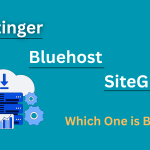In the evolving world of web design, speed and simplicity are everything—especially for entrepreneurs, bloggers, marketers, and small business owners. In this Elementor Review, I am discussing from the basics to the advanced.
Gone are the days of complex code and pricey web developers for every tiny change. Enter Elementor, one of the most powerful and intuitive drag-and-drop page builders for WordPress and WooCommerce, enabling anyone to create stunning, responsive websites without writing a single line of code.
Elementor Review: WordPress and WooCommerce Page Builder
Whether you're launching a personal blog, building a WooCommerce store, or developing a business website, Elementor gives you professional-grade tools with simplicity, flexibility, and speed.
In this blog post, we will explore Elementor’s core features, key benefits, theme compatibility, customisation options, alternatives, and answer some commonly asked questions.
Table of Contents
What is Elementor?
Elementor is a visual page builder plugin for WordPress, empowering users to create fully customized websites using a real-time, front-end interface.
Released in 2016, it has quickly grown to become one of the most popular website builders, boasting over 5 million active installations.
It also seamlessly integrates with WooCommerce, making it a powerful tool for crafting product pages, sales funnels, and entire online stores—again, with zero coding knowledge required.
Key Features of Elementor
1. Drag-and-Drop Editor
Elementor’s front-end editor is its crown jewel. You can drag elements (widgets) like text boxes, images, buttons, videos, and more into the page. No backend editing. No switching between preview and editor.
2. Pre-Built Templates & Blocks
With access to hundreds of designer-made templates, you can jumpstart your site in minutes. From landing pages to portfolios, you’ll find ready-to-go designs that suit your needs. The block system also lets you insert pre-designed sections, such as testimonials, pricing tables, or contact forms.
3. Responsive Design Controls
Elementor allows you to customise layouts for desktop, tablet, and mobile—each separately. This ensures your website looks fantastic across all devices.
4. Theme Builder
With Elementor Pro, you can customise your header, footer, single post templates, archive pages, and even WooCommerce pages, such as product or checkout pages.
5. Popup Builder
You can build pop-ups (email opt-ins, promotions, and announcements) with complete design control and trigger them based on user behaviour, such as exit intent, scroll depth, or time on page.
6. WooCommerce Integration
Elementor Pro includes dedicated WooCommerce widgets, so you can design custom product pages, shop layouts, and checkout pages using the same drag-and-drop tools.
7. Global Widgets & Styles
Create a widget once (like a button or call-to-action), reuse it across your site, and update it globally later. The same applies to fonts, colours, and spacing—keeping your design consistent.
8. Third-party Add-ons
A massive developer community supports Elementor, offering third-party plugins and widgets to expand your design and functionality capabilities even further.
Benefits of Using Elementor
- No Coding Required: Perfect for beginners or marketers who want complete control without hiring a developer.
- Time-Saving: Build pages in hours, not days. Templates and global elements save a significant amount of time.
- Design Flexibility: You’re not limited to your Theme’s structure—you can design every part of your site.
- Affordable: The free version is feature-rich; the Pro version offers enterprise-level capabilities at a low cost.
- Live Editing: What you see is truly what you get. Design in real-time on the front end.
- SEO-Friendly: Clean code output, fast loading pages, and compatibility with SEO plugins like Yoast or Rank Math.
- Community & Support: Large user community, Facebook groups, official documentation, and premium customer support.
Theme Compatibility
Elementor works with almost any WordPress theme, but it’s best paired with themes built to be lightweight and flexible. Some of the most Elementor-compatible themes include:
- Hello Theme (by Elementor) – Minimal and blazing fast.
- Astra – Highly customizable, lightweight, and perfect for WooCommerce.
- OceanWP – Feature-rich and multipurpose.
- GeneratePress – Clean, fast, and flexible.
Using one of these ensures maximum compatibility and smooth performance.
Customisation Options
- Custom Fonts & Colours
- Custom CSS (Pro Feature)
- Motion Effects & Animations
- Advanced Layout Controls (Margin, Padding, Flexbox)
- Role Manager (Limit editing access for team members)
- Dynamic Content (for blogs, WooCommerce, or membership sites)
You can even connect dynamic data, such as user information, post fields, or custom fields from ACF, Toolset, or PODS.
Best Elementor Alternatives
While Elementor is a top-tier tool, here are a few notable alternatives:
- Beaver Builder – Clean, developer-friendly, and lightweight.
- Divi (by Elegant Themes) – Highly visual and comes with its own Theme.
- Brizy – Modern and beginner-friendly with an intuitive UI.
- Gutenberg (WordPress Block Editor) – Built-in, lightweight, but less flexible than Elementor.
- Thrive Architect – Focused on marketers and conversion-optimised pages.
- Oxygen Builder – More developer-oriented with deeper control over site structure and CSS.
Each has its strengths, but Elementor strikes a better balance between ease of use and professional power than most.
Frequently Asked Questions (FAQs)
Q1: Is Elementor free to use?
Yes, Elementor offers a free version with essential widgets and templates. However, Elementor Pro unlocks advanced features like Theme Builder, WooCommerce widgets, Popup Builder, and more.
Q2: Do I need to know coding to use Elementor?
No. Elementor is completely no-code. Advanced users can insert custom CSS or JavaScript if desired; however, this is optional.
Q3: Can I use Elementor with any WordPress theme?
Mostly yes. Elementor works with almost all themes. However, using lightweight themes like Hello, Astra, or GeneratePress provides better results.
Q4: Is Elementor suitable for WooCommerce stores?
Absolutely. Elementor Pro offers WooCommerce widgets, allowing you to create customised product pages, shop layouts, and checkout experiences.
Q5: Will Elementor slow down my site?
Using too many widgets or animations can impact speed. However, with a lightweight theme and performance optimisation plugins (such as WP Rocket or LiteSpeed Cache), Elementor sites can be swift.
Q6: Can I build a complete website using only Elementor?
Yes. From header to footer, blogs to stores—you can build an entire website using Elementor and Elementor-compatible themes.
Final Thoughts
Elementor is much more than just a page builder—it’s a complete design system that empowers beginners, freelancers, marketers, and agencies to craft beautiful, responsive websites and WooCommerce stores effortlessly.
Whether you want to launch a blog, set up an e-commerce store, or create high-converting landing pages, Elementor offers the tools to do it all—without ever touching code.
Its active community, rapid updates, and plugin ecosystem ensure it stays relevant in the fast-paced digital world. If you’re looking to build a website fast, affordably, and beautifully, Elementor is a no-brainer.
Start with the free version to get a feel for it. Once you're comfortable, upgrade to Pro for the full power—and watch your website go from good to excellent in no time.
Want a comparison blog post on Elementor vs Divi, or a tutorial on “How to Build a WooCommerce Store with Elementor? Just let me know!







